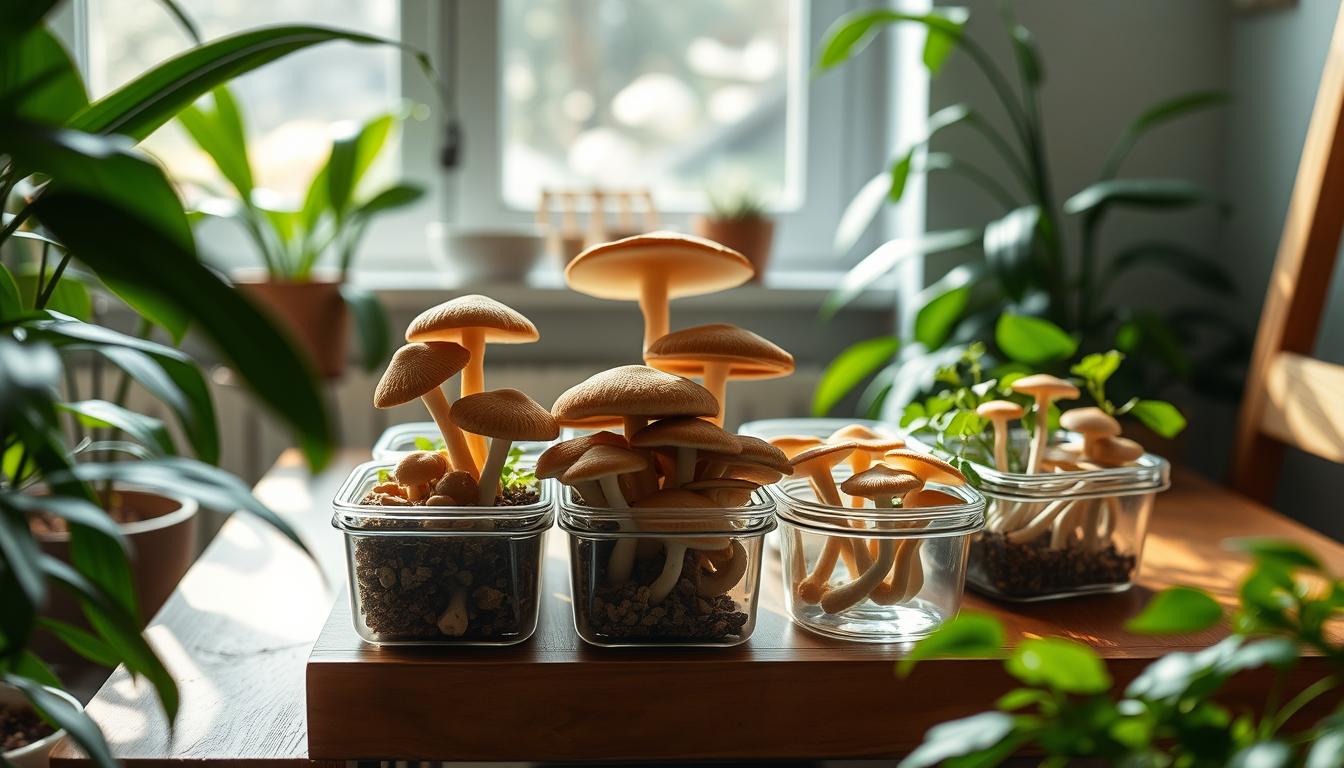Welcome to my mushroom growing guide! I’m excited to share how to grow mushrooms at home with you. As a fungi fan, I’ve found that growing your own mushrooms is both fun and rewarding.
In this guide, I’ll show you everything you need to know to start growing mushrooms. We’ll talk about choosing the right varieties, setting up your growing space, and harvesting your first crop.
Whether you’re new to gardening or want to learn more, this guide will help you. It will give you the knowledge and confidence to grow mushrooms at home. Let’s dive in and explore the fascinating world of homegrown mushrooms!
Why I Decided to Grow Mushrooms at Home
I started growing mushrooms at home out of curiosity. I enjoy cooking with fresh ingredients, and mushrooms are a favorite. I thought, “Why not grow them myself?”
The Benefits of Homegrown Mushrooms
Growing mushrooms at home has changed my life. The taste of fresh mushrooms is amazing. They’re full of nutrients and don’t have pesticides.
I can also grow rare varieties that stores don’t have. This is a big plus.
| Benefit | Description |
|---|---|
| Freshness | Harvest right before cooking for maximum flavor |
| Variety | Grow unique types not found in supermarkets |
| Cost-effective | Save money on expensive gourmet mushrooms |
| Eco-friendly | Reduce packaging waste and transportation emissions |
A Fun and Rewarding Hobby
Indoor mushroom cultivation is my favorite hobby. It’s cool to see the mycelium grow and mushrooms pop up. Every harvest is a win.
I’ve learned a lot about fungi and how to grow food sustainably. It’s rewarding.
Growing mushrooms is both calming and thrilling. It needs patience and care, but it’s worth it. I’ve found a community of mushroom lovers who share knowledge and celebrate each other’s wins.
Understanding Different Types of Mushrooms
When I began growing mushrooms at home, I was amazed by the variety. It’s a world full of possibilities for both newbies and experts.
Edible Varieties I Can Grow
Some mushrooms are easier to grow than others. Button mushrooms are a good start because they’re familiar and versatile. Oyster mushrooms grow quickly and come in beautiful colors.
Shiitake mushrooms take longer but have a rich, meaty flavor. It’s worth the wait.
Specialty Mushrooms for Enthusiasts
As I got better, I tried unique varieties. Lion’s Mane mushrooms are delicious and have health benefits. Enoki mushrooms add a gourmet touch to meals.
Trying to grow truffles is a big challenge. They need special conditions and a lot of patience.
How to Choose the Right Type
Choosing the right mushrooms depends on several things. I think about my skill level, space, and when I want to harvest. Beginners should start with oyster or button mushrooms. They’re easy and quick to grow.
If you have more space and patience, shiitake or lion’s mane are great. Make sure your mushroom choice fits your cooking style so you’ll enjoy what you grow.
| Mushroom Type | Difficulty Level | Growth Time | Space Needed |
|---|---|---|---|
| Button | Easy | 3-4 weeks | Small |
| Oyster | Easy | 2-3 weeks | Small |
| Shiitake | Moderate | 6-12 months | Medium |
| Lion’s Mane | Moderate | 4-6 weeks | Medium |
Essential Supplies for Growing Mushrooms
Growing mushrooms at home is an exciting journey. Having the right supplies makes all the difference. Let’s dive into what you’ll need to get started.
Recommended Growing Kits
Mushroom growing kits are perfect for beginners. They come with everything you need, including spores and substrate. I love how easy they make the process. You can find kits for various types of mushrooms, from oyster to shiitake.
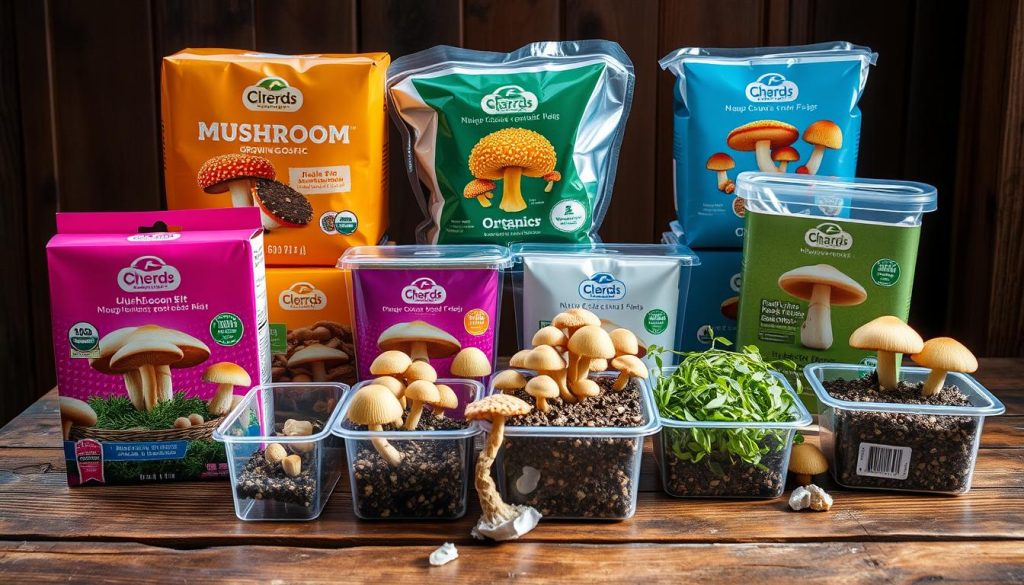
Tools and Materials I Need
If you’re ready to take a more hands-on approach, here’s what I use:
- Mushroom grow bags
- Substrate (sawdust, straw, or wood chips)
- Spores or liquid culture
- Pressure cooker for sterilization
- Spray bottle for misting
- Thermometer and hygrometer
Where to Find Supplies
I’ve had luck finding supplies both online and in local stores. Online retailers offer a wide selection of mushroom growing kits and specialty items. For basics like spray bottles, I shop at garden centers or hardware stores. Specialty mushroom suppliers are great for spores and grow bags.
| Supply Type | Best Places to Buy |
|---|---|
| Mushroom Growing Kits | Online retailers, garden centers |
| Mushroom Grow Bags | Specialty mushroom suppliers, online stores |
| Spores/Cultures | Specialty mushroom suppliers |
| Basic Tools | Garden centers, hardware stores |
Preparing the Growing Environment
Creating the perfect environment for mushroom growth is key to success. Mushroom fruiting conditions play a crucial role in cultivation. Let’s dive into the essentials of setting up an ideal growing space.
Ideal Conditions for Mushroom Growth
Mushrooms thrive in specific conditions. I’ve found that maintaining the right temperature, humidity, and light is vital. Most varieties prefer temperatures between 55-75°F and high humidity levels of 80-90%. I keep my growing area dimly lit, as mushrooms don’t need much light to fruit.
| Factor | Ideal Range | My Setup |
|---|---|---|
| Temperature | 55-75°F | Thermostat-controlled room |
| Humidity | 80-90% | Humidifier and misting system |
| Light | Dim, indirect | Low-wattage LED lights |
Setting Up My Growing Area
I’ve dedicated a spare closet for my mushroom farm. It’s equipped with shelving units to maximize space. I use a small humidifier to maintain moisture and installed a fan for air circulation. This setup helps create optimal mushroom fruiting conditions.
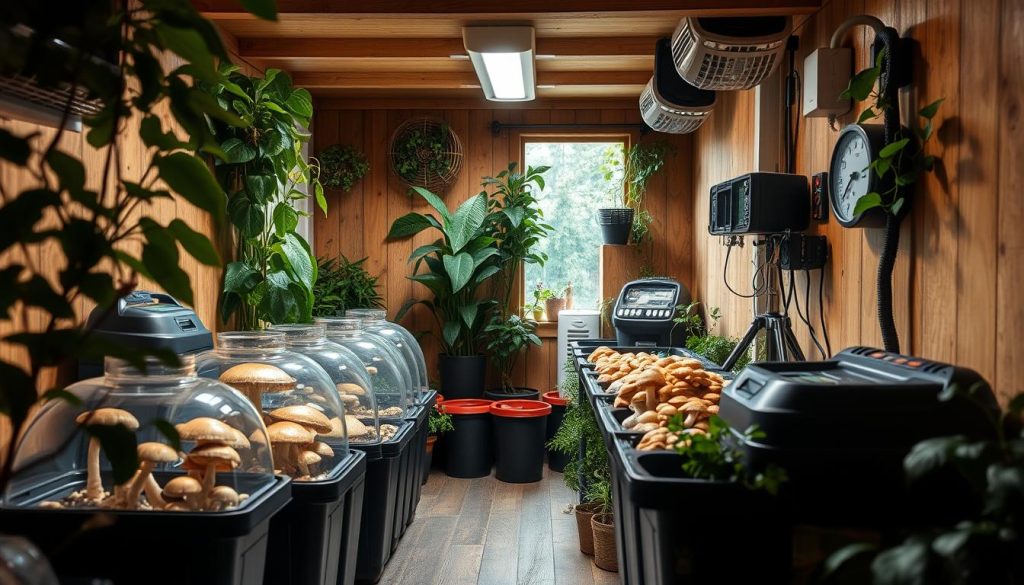
Importance of Cleanliness
Cleanliness is non-negotiable in mushroom cultivation. I sterilize all equipment and surfaces regularly with a 10% bleach solution. This practice prevents contamination and ensures healthy mushroom growth. Remember, a clean environment is crucial for successful fruiting conditions.
Choosing a Growing Method
When I began mushroom farming, I had to decide between a pre-made kit and DIY. Each option has its benefits, depending on your goals and what you have. Let’s look at these methods to help you choose.
Comparing Kits vs. DIY Methods
Growing kits are easy to start with and are perfect for beginners. They come with everything you need, ready to go. DIY methods, however, let you control the process and can save money over time.
| Aspect | Growing Kits | DIY Methods |
|---|---|---|
| Initial Cost | Higher | Lower |
| Time Investment | Low | High |
| Learning Curve | Gentle | Steep |
| Customization | Limited | Extensive |
| Yield Potential | Moderate | High |
Pros and Cons of Each Approach
I’ve used both kits and DIY methods. Kits are good for quick learning and results. DIY, however, requires more work but lets you experiment and possibly get better yields.
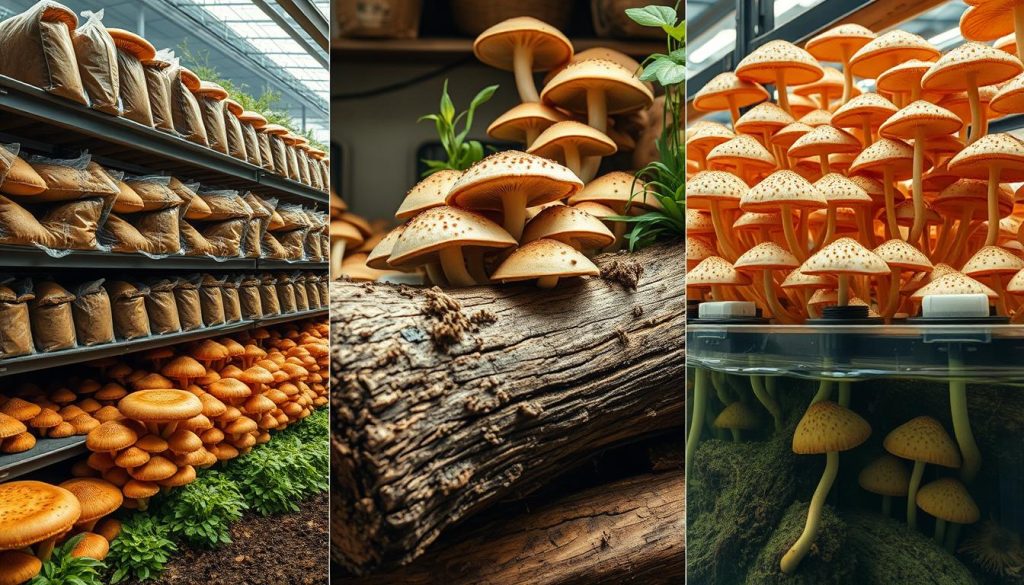
Your choice should match your time, budget, and learning desire. I started with a kit and then moved to DIY as I learned more. Both ways can help you grow your own mushrooms at home.
Inoculation: The First Step to My Mushroom Journey
I’m excited to share my experience with inoculation, the crucial first step in growing mushrooms at home. This process involves introducing mushroom spores or mycelium to a prepared substrate. It sets the stage for successful growth.
How to Inoculate a Substrate
Mushroom substrate preparation is key to successful inoculation. I start by sterilizing my substrate, usually a mix of hardwood sawdust and supplements. Then, I carefully introduce the mushroom culture using a sterile syringe or grain spawn. It’s important to work in a clean environment to prevent contamination.
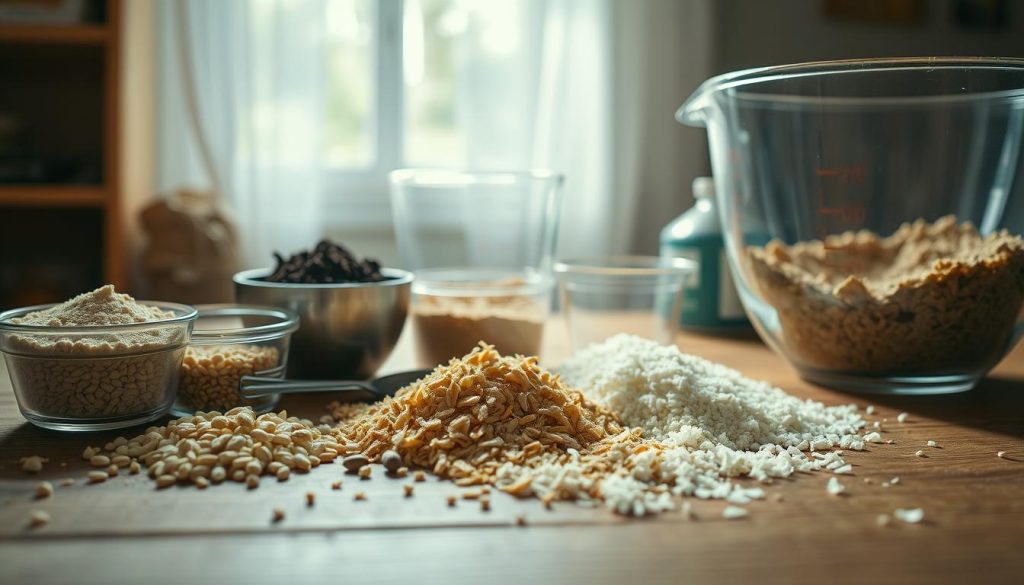
Best Practices for Success
I’ve learned some valuable tips for successful inoculation:
- Use fresh, high-quality spawn or spores
- Maintain strict cleanliness throughout the process
- Keep tools sterilized with isopropyl alcohol
- Control temperature and humidity in the growing area
Mistakes to Avoid
Through trial and error, I’ve identified common pitfalls in mushroom substrate preparation:
| Mistake | Impact | Prevention |
|---|---|---|
| Insufficient sterilization | Contamination | Proper pressure cooking or pasteurization |
| Overhandling substrate | Introduces contaminants | Minimize touching, use gloves |
| Poor moisture balance | Slow growth or mold | Aim for field capacity in substrate |
By following these guidelines and learning from my mistakes, I’ve greatly improved my success rate with mushroom cultivation. Remember, patience and attention to detail are key in this fascinating hobby.
Caring for My Mushroom Cultivation
Growing mushrooms at home needs careful attention. Success depends on the right conditions. Here’s how I keep my mushrooms thriving.
Watering and Humidity Levels
Mushrooms need moisture. I mist my area daily to keep it humid. A hygrometer helps me keep humidity at 80-90%. I avoid too much water to prevent mold.
Monitoring Temperature and Light
Temperature control is key. Most mushrooms grow best at 55-75°F. I check with a thermometer often. Mushrooms also don’t need much light, so I provide indirect light for 12 hours a day.
Recognizing Signs of Trouble
Being vigilant is important. I watch for color changes, bad smells, or slow growth. These signs can mean trouble. If I catch it early, I can fix it by adjusting humidity, temperature, or air flow.
| Issue | Possible Cause | Solution |
|---|---|---|
| Slow Growth | Low Temperature | Increase Heat |
| Fuzzy Mold | Excess Moisture | Reduce Watering |
| Dry Caps | Low Humidity | Mist More Often |
By watching these factors closely, I’ve improved my mushroom growing. It takes practice, but it’s rewarding!
Harvesting My Mushrooms
As my mushrooms grow, I eagerly await the moment when they’re ready for harvest. Knowing when and how to pick them is crucial for a successful yield. I’ve learned some valuable mushroom harvesting tips that I’m excited to share.
When to Know They’re Ready
Timing is everything when it comes to harvesting mushrooms. For most varieties, I look for fully developed caps that have separated from the stem. Button mushrooms are best picked when the caps are tight and closed. Shiitakes are ready when their caps are fully open but before the edges start to curl.
Best Techniques for Harvesting
I’ve found that gentle handling is key to preserving mushroom quality. I grasp the stem near the base and twist slightly while pulling upward. For cluster-growing varieties, I use a sharp knife to cut individual mushrooms at the base. This method helps prevent damage to neighboring fungi still developing.
Storing My Fresh Mushrooms
After harvesting, I store my mushrooms in paper bags in the refrigerator. This allows them to breathe while staying cool. For longer storage, I slice and dry them using a food dehydrator. Properly stored, my fresh mushrooms last up to a week, while dried ones can be enjoyed for months.
- Store in paper bags, not plastic
- Keep refrigerated at 32-36°F
- Clean just before use, not before storage
- Dry excess harvest for long-term storage
Troubleshooting Common Growth Issues
Growing mushrooms at home can be rewarding, but it’s not without challenges. In my mushroom growing guide, I’ll share some tips for tackling common issues.
Identifying Contamination
Contamination is a frequent problem in mushroom cultivation. I’ve learned to spot signs like unusual colors, foul odors, or rapid mold growth. If I see green, black, or bright orange spots, I know it’s time to isolate that container to prevent spread.
How to Revive Struggling Mushrooms
When my mushrooms struggle, I first check environmental factors. Adjusting humidity, temperature, or air flow often helps. If growth slows, I might add a light misting or adjust the substrate moisture. Sometimes, moving the growing container to a different spot does the trick.
Tips for Future Success
To avoid issues in future grows, I follow these steps:
- Maintain cleanliness in my growing area
- Use high-quality spawn and substrate
- Monitor conditions closely
- Keep detailed records of each grow
| Issue | Possible Cause | Solution |
|---|---|---|
| No growth | Poor spawn quality | Use fresh, reputable spawn |
| Slow growth | Low temperature | Increase ambient temperature |
| Deformed mushrooms | Insufficient FAE | Improve air circulation |
By addressing these common issues, I’ve improved my success rate and enjoy a steady supply of homegrown mushrooms. This mushroom growing guide has been a game-changer for my cultivation journey.
Maintaining a Continuous Supply
Keeping mushrooms growing is essential for success in indoor mushroom cultivation. By using a few techniques, I enjoy fresh mushrooms all year.
Techniques for Regular Harvesting
I stagger my grow cycles to keep a steady supply. Starting new batches every few weeks means I always have mushrooms at different stages. This method is great for indoor growing, where I can control everything.
Some mushrooms, like oysters, grow fast and often. Others, like shiitakes, grow slower but produce more. Mixing these varieties keeps my cultivation balanced.
Planning for Different Growing Cycles
Planning is key for continuous harvests. I use a calendar to track my batches, when they’ll fruit, and when to harvest. This keeps my mushroom growing efficient.
Extending substrate life is important. With proper care, I often get more than one harvest from a single batch. This maximizes my yield.
Using these strategies, I always have a fresh supply of mushrooms. It takes practice, but the joy of having mushrooms on demand is worth it.
Expanding My Mushroom Growing Skills
As I’ve explored mushroom cultivation, I’ve entered a world of advanced techniques. I’ve learned about agar work and liquid culture prep. Working with wild strains has been both challenging and exciting.
Exploring Advanced Techniques
Mastering these advanced methods has elevated my mushroom growing. Understanding the science behind it gives me control over the growing process. This has led to better yields and new varieties.
Joining Mushroom Growing Communities
Connecting with other mushroom lovers has changed the game. I’ve joined online forums and local groups. We share tips, solve problems, and celebrate our grows. It’s great to have a community that gets my passion for fungi.
Resources for Further Learning
I’m always searching for new knowledge. Books like “Growing Gourmet and Medicinal Mushrooms” by Paul Stamets are invaluable. Online courses and YouTube channels on mushroom farming are also great resources. The more I learn, the more I see how much there is to discover in this hobby.

